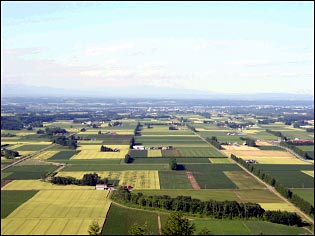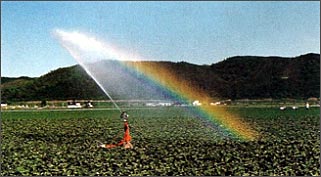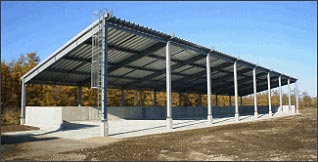 |
| Development
of Agriculture and Farm Villages |
|
Strengthening Hokkaido's role as a food base
| · |
Pioneering the construction of a recycling
society with a safe and secure diet lifestyle |
| · |
Building Hokkaido pastoral communities |
| · |
Promoting reform of the agricultural structure |
| · |
Realizing a secure nation and safe livelihood |
|
| Hokkaido, backed by abundant,
large-scale land resources, has reached a management scale of the level
of European countries. Centering on rice, field crops and dairy farming,
full-time resident farmers employ high land-use productivity methods. The
banner for the 6th term Hokkaido comprehensive development plan is “Realizing
a Global Scale Food Base.” |
In March 2005, the basic food
plan for agricultural and rural areas index for the nation's food, agriculture
and farm village promotion policy was reexamined. The new master plan, in
addition to establishing a new target for the self-sufficiency ratio, focuses
on maintaining a safe food supply, developing a stable management structure
with farmers ensuring the stable management of resource preservation measures
for farmland conversion and water for agricultural use. Also provision was
made for pro-active promotion of agricultural products export.
From this point on, while strengthening Hokkaido's role as a food base for
Japan, based on this master plan the focus will be placed on a variety of
factors including natural cyclical functions and the preservation of national
land and rural environments which agriculture has had from the beginning,
and even more important, revitalizing farm villages to support these.
For these reasons, the new plan promotes ensuring water resources for agricultural
use, farmland development, advanced development of agriculture and farm
villages and environmental improvement. |
 |
| Vast upland farming
area (Tokachi area) |
|
| [Development of Agriculture and Farm Villages
and its Role] |
The agriculture and farm village
development project divides roughly into agriculture infrastructure development,
farm village development and farmland preservation management and carries
a very important role in advancing the development of land and water resources
by contributing to the development of agriculture and farm villages.
Principal roles are the following:
| · |
Stable, safe supply of low-cost food and
realization of healthy eating habits by producing agricultural products
adapted to consumer needs |
| · |
Contribution to revitalization of the
economy by developing agriculture related industries |
| · |
Maintenance or formation of vitalized
communities by improving the living environment of farm village areas
and promoting co-existence and convective flow between urban and farm
areas. |
| · |
Contribution to water use by leveling
land and using local surface water |
| · |
Making great contribution to a number
of functions such as preventing floods and soil erosion, incrementing
water resources by developing anti-disaster dams, agricultural drainage
facilities and developing paddy land. |
|
| [Development of Agriculture and Farm Village
Development Projects in Hokkaido] |
Emphasizing the importance of
increasing the efficiency of a budget for agriculture and farm village development
projects, effort is being made to thoroughly implement time management policy
connected with a public works reform policy for achieving strict assessment
of the project, comprehensive cost reduction, participation of residents,
mutual alliance of projects, efficient use of existing social stock, etc.
| (1) |
Agricultural infrastructure
development project
The agricultural infrastructure development project strengthens and
stabilizes the agriculture management base and rearranges the agriculture
production structure by improving agriculture productivity and promoting
agriculture structure reform.
|
| |
 |
Development of paddy
land
The development of draining facilities and extensive compartmentalization
and combined use of farmland is promoted for the production
of quality rice and crop rotation for wheat, soybeans and other
forage crops in paddy land areas. |
 |
Development of dry-farming land
In dry farming and dairy farming areas, land adjustment, drainage
facility development and grassland improvement, along with improving
and stabilizing management is being conducted. |
 |
Development of basic drainage facilities
Basic drainage facilities are being improved, aimed at cooperative
use by dry fields and rice paddies. Also, there has been development
of drainage facilities contributing to environment preservation,
cooperating with the live stock industry's environmental development
project for proper processing and effective use of livestock
excrement. |
|
|
 |
| Dry Field Irrigation |
|
| (2) |
Farm village development project
While developing farm village living environment, the project plans
to preserve and create a natural environment that will result in revitalized,
rich farm village areas.
|
| |
 |
Comprehensive farm village
development
Comprehensive farm village housing and living environment development
is conducted using agricultural infrastructure. Also, there
has been development of facilities including appropriate disposal
of livestock excrement from dairy farms, returning it to farmlands
as compost and liquid fertilizer and development of an infrastructure
responding to the various farm needs for information. |
 |
Development of farm roads
With the promotion the modernization of agriculture production
and the rationalization of agriculture product distribution,
farm roads have been built and repaired for the purpose of improving
farm village environment. |
 |
Development of agricultural settlement
sewage facilities
Domestic wastewater from agriculture villages, facilities for
the disposal of foul water and rain water, and the development
of compost facilities for disposing sludge. |
|
|
 |
| Compost Facilities |
|
| (3) |
Farmland maintenance and management
project
With regard to farmland and agriculture facilities, pro-active prevention
and recovery of functions from various kinds of disaster have been
conducted as well as the recovery of good management and maintenance
of agriculture facilities.
|
| |
 |
Disaster prevention
measures
For the recovery farmland and agriculture facility functions
and also for proactive prevention of disaster the plan implements
the construction of disaster prevention dams, repair of reservoirs
and river structures for agriculture, measures to prevent landslides
and other disasters caused by the nature of the soil, etc. |
 |
Maintenance and management of the
agriculture facilities
As for agriculture facilities, function facilities are maintained
appropriately to extend their life, preventive maintenance is
conducted at optimum times and pro-active preservation and appropriate
maintenance management is conducted. |
|
|
|